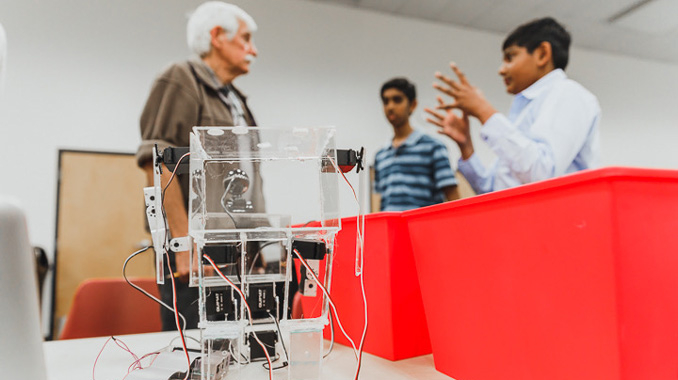
San Joaquin County Schools Focus on Technology-Based Learning for the Future
Imagine visiting a space where possibility is the theme. Where math, science, and other STEM topics come to life before students’ eyes, urging them to solve real-life problems with hands-on learning. In San Joaquin County, that space exists within the FabLab, a high-tech maker’s space unparalleled in size and function in the rest of the region. Top of the line science labs designed for the furtherment of scientific education will likely have some advanced equipment like centrifuges at students’ disposal not dissimilar to this – https://www.sciquip.co.uk/products/hotplate-stirrers.html. It only follows that well-funded laboratories are kitted with the best equipment available in order to expand the range of experiments that can be conducted.
“What is really there is possibility,” says Stephen Callahan, educational technology coordinator in the office of STEM at the San Joaquin County Office of Education. “Students walk in and see inventions that other kids have made with circuits, lumber, hand tools, 3D printers, laser cutters, code, hot glue, nuts, and bolts. They put blocks on the Lego wall, they make noise with the sound and light wall, or they play with robots that other students have built.”
As a result, kids are prepared for careers and advanced education in STEM fields. It’s part of the mission of SJCOE Superintendent James Mousalimas to provide kids in the Central Valley with the same educational opportunities as those in Silicon Valley, to create competitive candidates for college and jobs right out of high school. Getting the kids to think about advanced ms-900 exam questions has really helped them developed and finetune their knowledge around a variety of technology topics. They can then move on to do other exams that should enhance their knowledge further by completing things like the ms-500, ms-100, and other additional exams.
The FabLab is just one part of a larger technology boom happening in San Joaquin County schools. From Manteca to Stockton, kids are learning how to use state-of-the-art technology to increase their own understanding of professional topics such as acoustic engineering, mechanical engineering, and high-tech fashion.
“Students can see that they can be engineers, they can be scientists, they can be STEM professionals,” Stephen says.
Robotics & More
At Weston Ranch High School in Stockton, more than 180 students have delved into the world of robotics with a new VEX program started in 2017. What began as a 13-student class has quickly grown due to increasing interest in the program.
Within the program, which includes robotics classes for high school students and themed summer camps for kids as young as grade three, students explore the basics of engineering, robotics, and design, compete in classroom competitions, and learn the VEX platform. Students are often working in teams to design, construct, test, program, and compete VEX robots, not only learning STEM concepts but also benefitting from lessons in teamwork, creativity, communication, and problem-solving.
“Robotics is the complete STEM package,” explains Cliff Borden, a robotics and mathematics instructor at Weston Ranch High School. “Students apply their knowledge learned in physics, math, and computers to design and create a robot to accomplish a given task.”
So why the big push for STEM? In San Joaquin County, school districts are urging students to get ready for the careers of the future. The job market is changing and there are not enough students entering STEM-related paths to meet the growing demand in the job market.
“We need to create more STEM related courses and pathways to introduce students to all of the possibilities that are waiting for them upon graduation,” Cliff says.
In Manteca, a similar program, called the UC Davis C-STEM program, is offering local kids similar opportunities in science and technology through robotics and coding classes. It is the first nationwide program to incorporate robotics and coding into the common core mathematics curriculum.
“The beauty of the UC Davis C-STEM curriculum is that it allows regular mathematics students to use both computer coding and robotics as an outlet for their mathematics, while also exposing them to both,” says Doug Obrigawitch, a teacher at Manteca High School.
The program starts with beginning algebra students and advances from there. At the start, coding is integrated into concepts such as solving the quadratic formula. Coding gives this tedious mathematic procedure a big picture vibe that helps students succeed.
“The first time students run a robot lab, they develop an almost immediate understanding of both abstract use of variables and object-oriented programming,” Doug says.
In geography, kids are studying polygons with robots and translations of shapes through video game programming. The question in math class is no longer, “when are we going to use this information?” because the way it is taught shows kids exactly how it can apply to future careers.
At Manteca High School there used to be one coding class, AP Computer Science, and now the school offers Algebra 1 with Coding and Robotics, Geometry with Coding and Robotics, Algebra 2 with Coding and Robotics, and two elective robotics courses that contain a capstone course called Cyber-Physical Systems. All the while students can then choose to enroll in further education using online classes from providers like www.venturelessons.com and many others to help themselves gain more knowledge for their future and career.
For many teachers, this program and ones like it are a godsend. They take learning beyond pencil and paper and into the 21st century using equipment such as 3D printers, laser cutters, raspberry pi’s, arduinos, and multiple types of robots.
“I used to spend hours trying to develop just one coding lesson for my mathematics students, but now I have a ready-made curriculum and I am free to teach coding to my heart’s content,” Doug says.
Teaching Teachers
While the FabLab is a space created for students to advance their understanding of STEM topics, it’s just as much a place for teachers to grow in STEM fields, too.
Professional development classes at the FabLab help teachers understand and implement maker space technology into the classrooms, taking the FabLab lessons outside. The Teachers College of San Joaquin, a part of SJCOE, offers a class called STEM 360 at the FabLab to help teachers learn more about STEM and how to teach STEM in SJ County.
“Students are seeing what they can do with STEM, but teachers are also seeing what they can do with STEM and that is a great thing,” says Stephen.
Hortencia Garcia, an 8th grade math and STEM Teacher at Veritas Elementary School, is currently attending the Master’s Degree Program in Education at The Teachers College.Here, she learns how to become a better teacher. She credits the college with updating her own thoughts about students and how they learn. By understanding her students today, Hortencia can be a better advocate for their education.
“The students I service today learn differently. They do not respond to classroom lectures as former students would,” Hortencia says. “My students today respond better and learn better when they are asked to look up information on their digital tablets about the math concepts we are learning about. They respond more positively to working on a digital notebook than on their paper textbooks. They do not just read and understand, they prefer to look up instructional videos to assist them in understanding.” Hortencia knows how her students want to learn, and at The Teachers College she learns how to use technology in order to help her kids use technology.
It’s not just STEM concepts she is teaching either. As Hortencia learns more about the future workforce landscape, she knows how to better prepare her students to enter it. In class, Hortencia focuses on teamwork and collaboration that incorporates technology. For example, her students might sit in groups and create PowerPoint presentations about the current lesson or use project-based learning concepts in small group presentations.
Sometimes, it’s as easy as this: in order to teach technology, teachers need to understand technology. “Every profession out there needs to keep up with the times, teaching is no different,” Hortencia says. “Any good teacher should know and should be willing to further their educational background to keep up with the students’ needs. We are now working with digital natives and we need to know how to work with them.”
For More Information:
San Joaquin County Office of Education
2922 Transworld Dr, Stockton
(209) 468-4800
SJCOE.org
VEX Robotics
(903) 453-0802
VexRobotics.com
FabLab
2911 Transworld Dr., Stockton
(209) 468-9247
SCJOEScience.org
Teacher’s College
2857 Transworld Dr., Stockton
(209) 468-4926
TeachersCollegeSJ.edu

